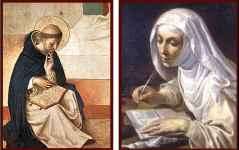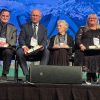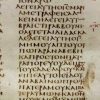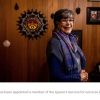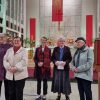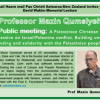DOMINICAN LAITY
Newsletter #26
February 2013
First the sad news: with regret, we must say haere ra to Norman Gray, at least for a while. Family illness has drawn Norman back to USA , and he has resigned from his position at Queenstown Hospital . Norman has been a strong and dedicated Dominican anchor as the small New Zealand Dominican laity has been slowly building in confidence. His experience with the Dominican Sisters of Peace in USA meant he brought wisdom and enthusiasm to our efforts. He has been a part of the consultative group that has given leadership, has assisted in the website (se below), and was on the Family Mission and Justice group. He is never presumptuous, always modest in his manner, and we shall miss him greatly. However, he holds New Zealand citizenship, and that gives us hope for the future.
_______________________________________________________________________________
New Website
Now the GOOD NEWS: After a great deal of work under the leadership of Teresa McNamara , the New Zealand Dominican website is up and running. You can see it at http://www.dominicans.org.nz/
It is still in the early stages of its final design, but it certainly is an impressive site even now. Thanks and congratulations to Teresa and Norman, and to all who have contributed. Plans to develop the site are now being considered, and suggestions would be welcome.
_______________________________________________________________________________
Notice: THE PEACE PLACE – if you are in Auckland
Peace Place has movie nights most Monday evenings.
Follow this link for details of their other regular gatherings:
http://thepeaceplace.org.nz/?page_id=45
_______________________________________________________________________________
SECOND VATICAN COUNCIL:
A 50-YEAR REFLECTION
At this milestone in the modern history of our Church, we invited people to write a reflection on how these 50 years since the Council have affected them: their faith, their approach to the Church, their hopes and disappointments. Here they are.
Reflections on Vatican II: Mary Nash
In this Year of Faith, we are encouraged to look back and reflect on the Second Vatican Council. In writing this, I was asked to consider how my faith has been affected in the years since Vatican II and how my Church responded to the challenges the Council made. My response to these questions came to me in a the form of a personal story which I hope sheds some light on matters.
From the age of 12, I attended a small Catholic boarding school in Suffolk run by the Sisters of the Assumption, a French order of teaching nuns, founded by Blessed Marie Eugenie in 1839. The school building was a beautiful 16th century Tudor mansion built by a Catholic family which had its own ancient church where we prayed and went to mass. It was the only medieval church in Suffolk to have remained a Catholic Church throughout the penal period. The owners were powerful enough to survive the legal penalties that came with refusing to join the Church of England.
That is where I was in 1962 when the Second Vatican Council began. These were formative years for my spirituality. I was comfortable with the Tridentine mass and had a daily St. Andrew’s Missal to guide me through it. I learnt and loved Gregorian chant. On a voluntary basis, many of us joined the nuns to sing the night prayer of the Church.
Catholics in Britain had been second class citizens for generations and in Northern Ireland they were still suffering. We were not allowed to go to protestant church services. Catholics could still be disadvantaged is subtle ways in public life. In my family, we grew up with these institutionalized spiritual obstacles which created differences between my protestant father and my Catholic mother.
Then the Second Vatican Council was launched to help breathe new life into the Church and reach out to Christians of other denominations in the spirit of ecumenism. It was an amazing initiative for British Catholics to witness and even be part of. In our churches, liturgical changes introduced a more intimate Mass, with the priest facing the congregation. Latin was replaced with English, at once making it easier to break open the word, yet at the same time perhaps reducing the awesome mystery of the Mass. Music was the big change, and for many, the virtual suppression of plainchant was a grief.
The ecumenical implications were also tremendous. We were to move on from the stories of persecution and leave behind the old siege mentality that still lingered. Instead, in a spirit of goodwill and fellowship, we were now allowed to attend weddings and funerals in those old parish churches which had once celebrated Mass in communion with Rome . I think it is hard for people in Aotearoa to imagine what a sea change this all was for British Catholics.
How has my faith has been affected in the years since Vatican II? –
I realized that the Church was not set in stone, that changes were possible and I saw how some people grew into and welcomed these changes while others held back, with reservations about the theological and liturgical implications of what was happening. I missed the spiritual culture I had grown up with and for years continued to do so despite recognizing the great opportunities and valuing the efforts towards openness, inclusion and outreach.
I came to Aotearoa in 1978, and really began to grow up! I realized the Vatican Council had brought about similar but different changes and opportunities here. In a country where there is no established religion, the divide between Catholic and Protestant had a different feel to it. I think we still need to work hard at growing liturgical expression that captures the beauty and the wonder of our spiritual heritages, of which we are blessed with many. In particular, I believe we are a long way from where we could be in relation to tangata whenua and their understandings and expressions of wairuatanga. They have a living tradition of spiritual expression which, for example, embodies our human connection to Mother Earth/Papatuanuku, to the environment, to mountains and rivers like the ones we refer to in the psalms, and we should be learning and taking new life from this wealth of expression.
_______________________________________________________________________________
From Pat Mullin
In reply to your invitation to write about Vat II here is an article I found some months ago in the National Catholic Reporter. It expresses my thoughts quite well. It is a series of bullet points composed by Archbishop Aymond of New Orleans
1. Vatican II presented a renewed vision of what it means to be the Church. The Council document Lumen Gentium on the nature of the Church called the Church a light for the world and the source of salvation. The document Gaudium et Spes on the Church in the modern world said the Church shares the joys and sufferings of the world. Both documents refer to the Church as the People of God, reflecting a new appreciation of lay people that surfaced repeatedly at the Council.
2. It called the Eucharist the source and summit of the faith. The Council’s document on the liturgy, Sacrosanctum Concilium, describes Holy Communion as the main source of God’s grace for Catholics. In the Eucharist, Catholics encounter the person of Christ. In this way, it is truly the foundation of the Church.
3. It reformed the liturgy. The changes to the Mass, perhaps the most well-known conciliar reform, promoted “full and active participation,” which led to the Mass being translated into the vernacular, or local language, and celebrated as a dialogue between the celebrant and the congregation. (Pat’s comment: “It reformed the Liturgy . . .” However this has been hijacked by some who want to re-enact the past by attempting to resurrect the pre- Vatican II Mass and mess around with the English we used in our Mass of today.)
4. It said every Catholic is called to holiness and to be a missionary. The document on missionary activity, Ad Gentes, expanded the view of how the Church evangelises. Missionaries were no longer sent just to remote areas of the world to spread the Good News; now all Catholics play a role in evangelising through their lives.
5. It emphasized the importance of the family. According to Lumen Gentium, the family is the “ Domestic Church .” While the faith of the Church flourishes in parishes, dioceses and nations around the world, before all else is the family. It is the family that provides a strong foundation for each believer.
6. It reshaped the Church’s relationship with other Christians and other religions. At Vatican II, the Church adopted a spirit of respect and dialogue toward other faith traditions. Ensuing dialogues have built bridges of understanding and strengthened relationships with Orthodox Christians, Jews, Muslims, Protestants and others.
7. It promoted collaboration. The document Christus Dominus encouraged “collegiality,” or collaboration within the Church. Bishops, priests, religious and lay people all work together in a way that didn’t in the past. Bishops collaborate through episcopal conferences like the U.S. Conference of Catholic Bishops and state-level Catholic Conferences. The Council also encouraged “subsidiarity,” by which authority is divided up and decisions are made at the appropriate level. (Pat’s comment: Yeah right! Obviously this message hasn’t arrived among the Roman Curia as yet.
8. It updated the Church… John XXIII saw Vatican II as a chance for renewal in the face of the “signs of the times” and said he called the Council to open a window and let in fresh air. This resulted in reforms that made the Church more accessible to the modern world, such as Mass in the vernacular and dialogue with other believers, and the openness of the Council was reflected in the presence men and women religious, lay people and even non-Catholics among its official observers. ( Pat’s comment: Yeah right! again. To quote the late Cardinal Martini ” [European and American] culture has aged, our churches are big and empty and the church bureaucracy rises up, our rituals and our cassocks are pompous. … The Church has remained 200 years behind the times. Why has it not been shaken up? Are we scared? Fear instead of courage?)
9. …but it also returned the Church to its roots. Vatican II also reformed the Church through a back-to-basics approach. This meant renewed appreciation for Scripture, the Church Fathers and the restoration of ancient traditions such as the permanent diaconate and the multi-step process for adults joining the Church.
10. Then-Father Joseph Ratzinger (now Pope Benedict XVI) played a significant behind-the-scenes role. The bishops at Vatican II were assisted by brilliant theologians. These assistants, or periti, included Joseph Ratzinger, who assisted Cardinal Josef Frings of Cologne , Germany . Father Ratzinger was involved in drafting speeches, shaping documents and defining the overall trajectory of the Council.
This year of faith looks back to Second Vatican Council and forwards at the same time. Our spirituality grows in context. We have to reflect on what our context is and what it offers us. My spirituality was formed before and during the Council, it was probably more devotional than liturgical, both of which are important. The great thing to remember is that change is an opportunity and we can voice our love for God in many ways. I hope that with attentiveness and imagination we can look after our spiritual traditions and keep growing inspirational ways to express and share them with the coming generations.
_______________________________________________________________________________
Vatican II and me – Mike Kelly
I was the sterotype convent school boy. Regular altar boy duties at New Brighton church of Mary Immaculate . Mass, benediction, rosaries, weekly confession. It was a routine that was easy to fall into. Ad Deum qui laetificat iuventutem meum – I remember it all. And the choir, the Gregorian chant. As I grew up, the Catholic Youth Movement, and I was aware of change in the air, especially with priests like John Curnow about, but the ecclesial pattern was still pretty rigid.
Then there were 10-15 years when I drifted away from Church. A meeting of bishops in the Vatican was just another news item for me. By the time I returned, things were already changing. People were discussing things in ways I had not heard before. I recall the shock of hearing a religious sister comment that she thought it would be pretty hard to commit a mortal sin. I had been taught mortal sin was an ever-present danger! And then the church community I started to attend soon asked me to read at Mass….and communion came in both species….and there was a strong social gospel being preached……..and parishes had pastoral councils….people began talking about the priesthood of the laity, and how Mass was not the presence of God called in a monologue by the priest but the action of the people of God gathering together, sharing the Word, and calling God to be present through the words of the priest and sharing the Eucharist (that was a major discovery for me!)….. and then someone asked me to preach!
So there were some very obvious changes in the way the Church operated. I was lucky to be in touch with some remarkable priests and Christian communities that were in a serious search for God. Among the priests: Eugene O’Sullivan OP, Terry Dibble, Peter Murnane OP, Neil Darragh. Worshipping communities at St Clare’s and St Benedict’s. There was a sense of liberation, of being empowered to think new things, to try new, creative liturgies with lay women and men to the fore, there was a sense of challenge. The old formulaic style of prayer changed for me into a constant search for God in my life and in the world. I recall the 1981 Springbok tour as a time not just of social awareness but a time of new discoveries in the meaning of faith. Increasingly the Dominican connection became stronger, and it continues to be the fount of grace for me.
Meanwhile outside the little groups that I found fulfilling there were disturbing things happening. The collegial principle that Vatican II had promoted, that decisions about Church needed to be emerge out of genuine consultation among the bishops around the world, was collapsing. A retro movement began to strengthen, both in the Church and in the church, and soon there was a discordancy that spread and began to weaken the perception of God’s people at work in the world. From Humanae Vitae to new translations of the Mass, from the scandal of clerical abuse to sacking theologians considered dangerous, we now face a Church administration determined to haul back on the new life that was breathed into our Church by Vatican II.
We live in troubled times for our Church, and at times I get angry at what I see as injustice. But my experience of these 50 years since the Council, in the company of so many people of clear vision, assures me that the goodness and wisdom of that time will finally shine through and the Spirit will renew the Church, as has happened so often before. Veni Creator Spiritus…
_______________________________________________________________________________
Random reflections on life after Vatican 2 – Judith Crimmins
1963: Midnight Mass – Leysin, a Ski resort in the Swiss Alps. My 1st Mass in a non-English speaking country. How wonderful I wrote home. Here I am at Mass and can understand it all. It is all so familiar – we truly are a universal Church. I felt at home despite the fact it was all in Latin and the sermon was in French!!! What did I understand? The ritual I guess!! And maybe, being with people of the same faith tradition.
1966: Whanganui: Attendance at Wellington Diocese Laity Conference. Vatican 2 documents are unfolded and discussed. Wow! Is this what it’s about? Mind blowing!
2013: Gt Barrier Island . I am leading the Liturgy of the Word and Holy Communion in English as I have done regularly since 2003. Here, I have been called the ‘lady priest’. Could this have been envisaged in 1963? Not by me, or anyone like me!
What happened in those intervening 50 years? Major changes? – No, it was back to earlier times, we were told. Mass in the vernacular – in language that any of us could understand; Study and education for people beyond those studying for the priesthood; Theological degrees; Scripture classes and seminars; Lay leadership training; Lay pastoral workers; Encouragement to lead rituals; Encouragement to think about life issues from a theological perspective.
As I wandered about St Peter’s in 1963, the Council of Vatican 2 was in full swing. My understanding of what it was about then was extremely limited. It all sounded exciting and important. It was something to do with ecumenism, wasn’t it? Certainly I didn’t see myself as ever leading any kind of liturgy, much less having this responsibility in a parish. I was in effect, a passive observer who prayed the given prayers and tried to live well! I rarely thought about, or questioned, how the church was run.
I did not see myself as ever leading any kind of liturgy. So, how has Vatican 2 affected my faith and contributed to the life I have? There were gradual awarenesses. Training boys (not girls, women could not go on the altar!) at CCD class to read at Mass: Opportunity to be a missionary without being a nun (I spent 2 years with COVS in Papua New Guinea); Being invited to be on the Diocesan and National Commissions for Justice and Peace and consequent overseas representation; Feeling of awe at being asked to be a Eucharistic Minster and to be on the liturgy committee; Singing hymns that related to my experience here in Aotearoa-NZ; Finding out there were ways of enhancing my prayer life other than through rote prayer; That there was such a thing as spiritual direction; Being invited to be part of the Dominican Preaching Team. And there were many, many other opportunities that brought insights and questions about my faith that helped me in my everyday life and also helped me deepen myself in a spiritual way.
From where I ‘sat’ in the 60’s and 70’s the Church responded enthusiastically to Vatican 2, creating, as said above, many opportunities for development for people like me. However from where I sit in 2013 there are times when I feel dejected. No longer does some of the language make any sense to me.
There seems to be no acknowledgement that English is spoken and understood differently in many countries. Then there is the non recognition that women and married men could be members of the ordained ministry, other than the diaconate. This actually inserts another layer to the hierarchy and reinforces celibate male domination. There is the sadness of seeing some of my fervent Catholic friends, although prayerful and truly living out the gospel message, no longer feeling sustained and so turning away from Catholicism because of these and other aspects of today’s church.
I am, however, reassured that there are bishops, and leaders of religious orders in the world who are questioning the imposition of many things from Rome even though they themselves lose favour with Rome . It is these leaders who give me hope for the future. And so I believe that we, as laity, have a responsibility to support them as well as continuing to keep ourselves well informed.
_______________________________________________________________________________
My memories of the Second Vatican Council Dorothy Coup
When the Second Vatican Council opened I was a young journalist working for Zealandia. I felt as if I was at the heart of what was going on because at the newspaper, we were among the first to hear what the bishops were doing.
It was our job to print the stories, interview the bishops when they returned from Rome and report why Pope John XXIII was calling together all his fellow bishops and how a new spirit was blowing through the Church.
Pope John XXIII had said: The council now beginning rises in the Church like the daybreak, a forerunner of a most splendid light.”
As the news unfolded our subscription numbers doubled and the orders for parish churches increased by the thousands.
Something was happening in Rome and Catholics wanted to know about it. It was so exciting as everyone became involved in the changes.
Because it wasn’t only about what the bishops were doing. As I heard Bishop Reginald Delargey emphasise to large groups of Catholics on many occasions: “You are Church”.
And people took his message seriously.
They attended talks and seminars to understand the reasons for the changes and took part in training sessions for their new roles in liturgy and responsibilities on parish and diocesan level. Religious groups, particularly women, looked different as they changed habits, but more importantly studied their charism and revitalised their orders.
Not only did we, as the Catholic press, publish the documents when they were released, but we continued with the stories about the changes which kept coming. English in the Mass, house Masses, folk music at Mass, Bible groups, parish councils, ecumenical group activities.
Catholicism had become controversial, a topic for conversation, a new exciting way of life.
I had been part of the traditional Catholic system – Catholic schools, learning the catechism, Sunday Mass, regular confessions, parish missions, occasional retreats, obeying the rules. But I was also involved in the lay apostolate movement, Young Christian Students at school, then the Catholic Youth Movement. Both had an emphasis on reading the gospels, group discussion and living out Christ’s message in the world beyond the church pews and the spiritual reading of the church pamphlet rack.
The Second Vatican Council seemed to be a blessing on this new approach. Surprisingly so many of these early movements inspired by Cardinal Joseph Cardijn faded out after the Council. Maybe their members felt that work was done and they were now ready to move to the next phase – the challenges of Vatican II.
Since the council many people have left the institutional Church, the priesthood and religious life. Some blame the Council and think a return to the old ways, the tried and true, will save what is left and attract people as it once did.
What happened? There are no simple answers but I wonder if we were so busy with the internal changes we failed to realise that although we took on new roles, being readers or distributors of Communion at Mass or members of the parish council, many of us became too involved in the Church structure. The new spirit blew through the Church but so many shut the doors and windows to stop it blowing us out to the world.
But even if we look back sadly, wishing again for those heady days of enthusiastic change and new ideas and reportable, radical action and instead see the Church slipping back to the safe old days and ways, we can take heart.
The Second Vatican Council was a mighty gust of wind, but now it could be time for the Spirit to be the gentle wind of the Old Testament seeking out those who are trying to bring about the kingdom of heaven here in our world.
Remember the Council was called “ a forerunner”. The “splendid light “ is still to come.?
_______________________________________________________________________________
Notes From Pax Christi Retreat Day November 2012
Overall theme: Insights from Vatican II – Kevin McBride
The morning began with a liturgy which called us to recall our ancestors and those who have gone before us in the way of justice and peace.
Mentioned in a Litany for Activists and Peacemakers were: Te Whiti o Rongomau and Tohu Kakahi, James K Baxter, Mother Suzanne Aubert, Kate Sheppard, Fr Terry Dibble, David Wakim (founding President of Pax Christi Aotearoa-New Zealand and passionate advocate for justice in Palestine), Peter Blake, St Mary of the Cross, Rachel Carson, Sr Dorothy Stang, Wangari Muta Maathai (founder of the Green Belt movement in Kenya). After thanking God for these role models and in particular, the memory of the shame of the invasion of Parihaka and the creative vision of Te Whiti and Tohu which inspired Mahatma Gandhi and Martin Luther King, we were asked to reflect on “our own family and friends and others who have gone before us and left us their mantle of encouragement to work for peace.”
In our next exercise, we first reflected on scientific insights which perceive the “seamless entity evolving “within” the Universe” and Earth’s “breath-taking cycle of life, changing and dying into the whole and emerging ever new.” This was linked in turn to our commemoration in the month of November of those who have gone before us: “our Ancestors, the Communion of Saints [whose spirit is] imprinted on our land and inextricably linked to us in Pax Christi.” We were then asked to plant seeds to recognize “this link between memory, life and mystery … that life doesn’t disappear; it simply changes form.” We shared reflections and insights relating to these ideas then planted given seeds in our own pots.
In the third part of the day, we took copies of Paras 77 and 78 of “Gaudium et Spes”, the “Pastoral Constitution of the Church in the Modern World”, one of the foundational documents of Vatican II. The section begins: “The Council wishes passionately to summon Christians to cooperate, under the help of Christ the author of peace, with all people in securing among themselves a peace based on justice and love and in setting up the instruments of peace.” Each of us then went to a quiet place to consider a group of six questions and to reflect on “instruments of peace” in our own life, family, parish and diocese. Later, we returned to the group to share any insights or prayers arising from this reflection.
Some of the insights which emerged were:
- Instruments of peace include: dialogue, sharing, listening, forgiving, reconciling, respectful relationships
- They benefit the powerless and powerful, winners and losers, everyone
- They help secure justice-based peace and love when listening ˃ understanding ˃ sympathy ˃solidarity ˃ option for the poor and oppressed ˃
- They are built up through the prayer/study/action and the hermeneutical cycle
- Jesus death on the Cross was the epitome of action for the common good of all, “the many”, irrespective of who or what they are.
- “Instruments of peace” are under constant attack from individualistic consumerism which could be termed “anti-Christ”. “Peace I give you; not the peace the world gives.” Success as the world promotes it is based on great material riches achieved through the market or marketing of technological innovations – the peace of Christ is found in the small things done well for the common good.
Finally, before the closing prayer, we were invited to participate in “a mindfulness walk in peace” based on hand-out copies of an article by John Dear SJ in the National Catholic Reporter of 23 October 2012. This involves “walking slowly in silence with others [encouraging] one another to be fully aware of our breathing, our walking, our prayer, our peaceableness”. It originated with Vietnamese Buddhist peacemaker, Thich Nhat Hanh. The gardens of Pompallier Centre in Ponsonby made a perfect setting for the exercise.
Our closing prayer began with “Mo Maria”, the hymn attributed to Bishop Pompallier, and included a Prayer Rosary wherein a list of troubled countries, such as Fiji , Sri Lanka , Palestine , Iraq and Afghanistan is recited as “The names slip through our fingers / like bloodstained beads.”
_______________________________________________________________________________
(The next item is from a New Zealand friend with Dominican roots, now living in an English city. She is writing in reply to a letter from Mike)
I shall try to say a little about my life here. Some of the things you say of your parish life there I certainly recognize, but I truly say it is all of that and ‘worse’ still here! Perhaps I’ve learned in my years here to laugh rather more and let a whole lot more go than I used to. Like you, I do not (cannot?) walk away from my ordinary city parish. But I kid you not, a fair majority of my fellow parishioners would scarcely have heard of Vatican II let alone grasp the revisionist assaults mounting against it now. It is not just one or two young friars in their elaborate exaggerated new vestments (such a small vanity really), it is the faithful mass-goers who clomp across the centre aisle, in the middle of the gospel or the consecration, to clonk coins into votary boxes of favorite saints and group around their shrines. It is people too scared to go up to receive Communion because they haven’t been to confession. It is the Salve Regina said after Communion…It is the noise: mobile phones, chatterings, bangings about the church… It is the lack of a parish council. And it is the woefully un-catechized acceptance of all of this. For that I do not blame the people, but I do wish the friars would at least try to catechize, ‘preach’ – wasn’t that a good word of the Dominicans? toward deeper Christian sensibilities.
Some things change very slowly here. We’ve only just started to use the new English mass words. Not that you’d notice, really. People use whatever responses they want, in diverse languages and forms. It is generally a poorer and immigrant parish, and I go there to be and pray among the people, my neighbours. Perhaps it’s what you and Jenny are doing too – we are there, ‘down’ among the people. Just presentfully being there, and not walking away, or grumbling too much, is a form of solidarity with the poor. We are not so proud as to walk away. And I have a dear friend there, in her 80s and more contemporary than anyone I know.
_______________________________________________________________________________
If any of our readers find something in these reflections on Vatican II that rings a bell for you, your responses would be welcome.
Blessings and peace.
Mike Kelly and Jenny Wilson
Newsletter Co-ordinators
Ph 06 370 2084
Email:kelly.wilson@ihug.co.nz
